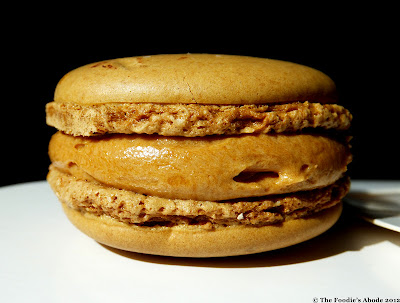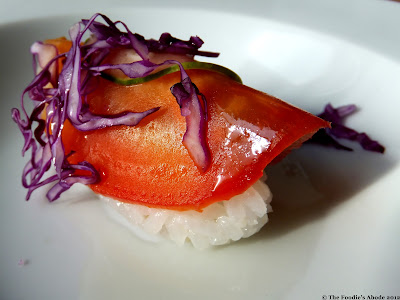As part of my recent Paris sojourn, I visited the Pierre Hermé flagship on Rue Bonaparte in the St. Germain area twice to sample his full range (well, almost) of macarons and pastries. This man needs almost no introduction in the world of pastry chefs: having trained at luxury patissiers Gaston Lenôtre, Fauchon and Ladurée before striking out on his own, he has won numerous accolades such as Pastry Chef of the Year in France, and is the only pastry chef to have been awarded the Ordre des Arts et des Lettres, as well as the Chevalier de la Légion d'honneur by former French president Jacques Chirac. Hermé has also been dubbed 'The Picasso of Pastry' by the French Vogue magazine for his innovative creations, which like dishes in a fine restaurant or designs in high fashion, are often seasonal and/or thematic in nature. He is particularly renowned for his macarons, many of which feature unusual flavour combinations.
None of the Hermé boutiques have a sit-down salon - the only real disadvantage compared to other luxury cafés in Paris I think - so one simply has to do a take away and settle down in a nearby park for consumption. We were lucky to have our hotel just round the corner, so we went back immediately after each visit to photograph and sample the pastries and macarons in their freshest states.
Macaron 1 (large): the signature Ispahan, a combination of rose macaron biscuit, fresh raspberries, rose petal cream mixed with juicy bits of lychee. This has been likened by Hermé to a Chanel suit - the most popular staple in the range of macarons. The sweetness of the rose petal cream and lychee mixture was a completely apt balance for the tart raspberries. This masterpiece also displayed an impressive variety of textures - from the juicy bits of fruit, to the velvety & smooth cream and the incredibly light & crisp biscuit layers. Not least importantly, the subtle aroma of roses rode upon every bite of this delicious morsel.
Macaron 2 (large): Yasamine, a combination of plain macaron biscuit, jasmine tea cream, fresh mango compote and house-candied grapefruit. Though not quite as flamboyant-looking as the Ispahan, the range of textures here was equally impressive, and in terms of aroma this was even more intense and intoxicating. Beneath the sweetness of jasmine cream and pieces of fresh mango lay a hint of acidity and bitterness from sprinklings of grapefruit, to stimulate the tastebuds with every bite.
Macaron 3: Infiniment chocolat Porcelana, a pure chocolate macaron made of single-origin Venezuelan Porcelana beans. Pure heaven for chocolate lovers - the cream was wonderfully indulgent with intense cocoa flavours and a long aftertaste.
Macaron 4: Infiniment rose, essentially a simplified version of the Ispahan with rose macaron biscuit and rose petal cream. Not quite as complex as the latter, obviously, but still very good with an exclusive focus on rose aromas and a surprising depth of flavour - sweet but light, fresh, and non-cloying.
Macaron 5: Médélice, a combination of lemon macaron biscuit, lemon cream, delicate hazelnut flakes (on the biscuit's surface) and praline. An effective and well-proportioned contrast between predominantly fresh & acidic lemon cream, and a small dollop of rich & sweet praline on the side. The nutty components of this macaron gave it a wonderful character and intensity in flavour amidst the surrounding lightness.
Macaron 6: Plénitude, a combination of chocolate and caramel macaron biscuits, dark chocolate chips with fleur de sel, bittersweet chocolate ganache, crunchy caramel. As the name of this macaron suggests, this was a picture of pure decadence (look at the smooth and glistening outer ganache layer!) wherein full-bodied cocoa flavours were given a further salty & buttery edge (from the caramel and fleur de sel). The firm and crunchy bits of chocolate chips and caramel also contributed a most pleasing bite to the overall texture.
Macaron 7: Infiniment caramel, a pure fleur de sel salted butter caramel macaron. This was simple yet powerful. The sweet-savoury balance was perfectly achieved, with a subtle charred hint to the taste, and the cream layer had an utterly velvety & luxurious mouthfeel.
Macaron 8: Mogador, a combination of passionfruit macaron biscuits dusted with cocoa powder, milk chocolate cream and fresh passionfruit pieces. A staple in the range of macarons, this unlikely partnership produces some rather amazing results. The juicy & acidic passionfruit cuts through the surrounding rich & sweet chocolate cream, and invigorates the latter with its characteristic aroma and flavour.
Macaron 9: Éden, a combination of peach, apricot and saffron. The light and pleasing fruit components were hugely elevated by the addition of expensive and exotic saffron, with subtle hay aromas. This spice also contributed a most vivid golden yellow hue to the cream layer, which made for incredibly attractive viewing despite its apparent simplicity.
Macaron 10: Jardin du Paradis, a combination of aniseed and saffron. This was part of ten macarons in Hermé's ongoing 2012 'Collection Éphémère: Les Jardins' series, released gradually in small amounts from February to November (one new macaron per month), in which fleeting pleasures are evoked in the form of fragrances, produced by different herbs and spices (hence the name 'Ephemeral Collection'). This macaron for June (thankfully still in production when I visited) was a most interesting experience; as the two spices started to unfold and linger on the palate they displayed an incredible balance, remaining distinct yet not overpowering the other. Eventually, the more resilient aroma of aniseed emerged to finish on a refreshing and subtly sweet note, whilst the discreet hay-like aroma of saffron faded away.
Macaron 11: Mosaïc, a combination of vanilla macaron biscuits, pistachio cream flavoured with cinnamon, and griottines (morello cherries macerated in eau de vie or kirsch). This was one of my favourites; apart from looking really pretty, the curious flavour combinations worked surprisingly well. The characteristic taste of pistachio was unmistakeably present in the rich and smooth cream, and its flavour was enhanced by the infusion of extremely aromatic and sweet-smelling cinnamon. The cherry bits nestled within the cream layer provided a delightful contrast with their juicy texture and mild acidity, and the process of maceration in liqueur also contributed a full-bodied and slightly bitter edge to the macaron, which complemented its predominantly nutty flavours perfectly. The vanilla biscuit layers, playing a naturally supportive and versatile role, were the ideal foil for this complex array of flavours.
Macaron 12: Infiniment jasmin, layers of jasmine flower macaron biscuit sandwiching a rich jasmine tea cream. This elegant and dainty piece was my absolute favourite within the entire range, and proof that sometimes simple is best. The enchanting aromas of jasmine were present in full force, providing pure, unadulterated pleasure. I have no idea what the silvery sprinklings on the biscuit layers were, but the air of sophistication that they imparted to the macaron on the whole was evident.
Macaron 13: Jardin d'été, a combination of lemon and caramelised fennel. The most current release in the 2012 Les Jardins series, this was an incredibly light, clean-tasting and well-balanced macaron. Tiny caramelised cubes of fennel set atop the smooth lemon cream layer both contributed a nice bite in the texture and enhanced the refreshing tartness of the lemon with a subtly aromatic and sweet aniseed flavour. A very different take on lemon from the Médélice (Macaron 5), and no less brilliant.
Pastry 1: 2000 feuilles, Hermé's take on the classic French millefeuille dessert, consisting of alternating layers of flaky caramelised puff pastry crust, crushed Piedmont hazelnut praline, and praline mousseline cream. This was definitely the best millefeuille that I'd ever had. The naming of this pastry, suggesting a double intensity, was not unjustified - never have I tried a more densely packed millefeuille with such unabashedly indulgent and flavourful layers. The range of textures was impressive - from the crispy, feather-light Brittany-style crêpe dentelle biscuit layers, to the grainy praline with a wonderful crunch, and the smooth, velvety mousse. It was so good I bought it again on my second visit to the boutique. Tip: this should definitely be enjoyed as soon as possible - the second time I ate it in the evening, after having left the pastry box in the hotel room for a few hours, and it had 'melted' and collapsed into a thinner and denser pile meanwhile - not the prettiest thing to look at, though it still tasted quite good.
Pastry 2: Carrément chocolat, a whole dark chocolate-based layered slab consisting of moist chocolate cake (similar to a moelleux), rich chocolate cream, chocolate mousse, bits of chocolate croustillant, thin & crispy chocolate wafers. A slice of the divine with every imaginable variation of chocolate included, this had an overwhelming intensity and was almost too much of a good thing, but I certainly wasn't complaining - desserts should be sinful or there'd be no point having them!
Pastry 3: the pastry version of the Plénitude macaron. The dark chocolate dome was coated with pieces of dark and white chocolate, and contained layers of chocolate macaron biscuit, dark chocolate chips with fleur de sel, dark chocolate mousse and ganache, and crunchy salted butter caramel. Very similar in composition to Carrément chocolat but somewhat more balanced, with an appealing savoury edge from the caramel and fleur de sel.
Pastry 4: peach, rose and cumin tart, inspired by Femme, a fragrance by perfumier Rochas. This delicate creation consisted of a pâte sablée crust coated with cumin-spiced sugar, which contained slices of fresh yellow peaches on a bed of almond cream infused with the subtle flavour of roses. Next to 2000 feuilles this was my favourite piece; the juicy peaches went hand-in-hand with the mildly sweet almond cream, and I thought that the use of cumin was an ingenious touch - the characteristic aroma of this exotic and enthralling spice was present in every mouthful and made for a most memorable experience. Due to the somewhat overpowering nature of this spice, the rose infusion within the cream became rather difficult to detect, but perhaps I wasn't missing out on too much?
Pastry 5: Désiré, a lemon, strawberry and banana creation. A base of pâte sablée and lemon biscuit lays the foundation for a dome of incredibly light lemon cream, with a layer of banana and strawberry compote in the middle, and topped with fresh raspberries. On the whole this was very refreshing and clean-tasting - predominantly acidic, but with a good measure of sweetness from the flavourful and chunky compote for balance. A very nice way to end my exploration into Hermé's world of desserts.
The two visits to Hermé's flagship boutique in St. Germain yielded an extraordinary discovery of flavours, aromas and textures, and impressed with every creation's attention to detail. This definitely wasn't just about desserts looking pretty or pursuing novelty for their own sake; ultimately the proof of the pudding is in the eating, and on that count, everything I had tried passed with flying colours. I look forward to sampling more inspired creations from this master pastry chef in future!






































































